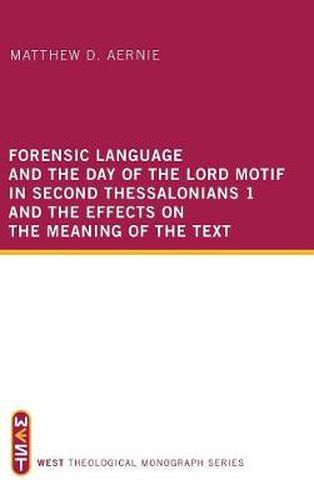Readings Newsletter
Become a Readings Member to make your shopping experience even easier.
Sign in or sign up for free!
You’re not far away from qualifying for FREE standard shipping within Australia
You’ve qualified for FREE standard shipping within Australia
The cart is loading…






This title is printed to order. This book may have been self-published. If so, we cannot guarantee the quality of the content. In the main most books will have gone through the editing process however some may not. We therefore suggest that you be aware of this before ordering this book. If in doubt check either the author or publisher’s details as we are unable to accept any returns unless they are faulty. Please contact us if you have any questions.
In this book, Matthew Aernie argues that Paul intentionally used forensic language, allusions, and idioms throughout 2 Thessalonians 1 in order to encourage the persecuted church to remain steadfast as they waited for their vindication at the final assize. To support this thesis, Aernie suggests that such judicial language and allusions are intertextual parallels originating primarily from the Day of the Lord motif found throughout the Old Testament, and maintains that the Day of the Lord concept was understood by the author of the Thessalonian correspondence as a reference to the day when the Lord would render righteous verdicts upon those who had both obeyed and disobeyed him. Furthermore, Aernie argues that the author of 2 Thessalonians likely understood the Day of the Lord to be consummated at the Parousia of Christ, when the final court would convene. Therefore, borrowing from the judicial concept apparent in the Day of the Lord motif, Aernie concludes that the author utilized forensic language throughout 2 Thessalonians 1 to exhort the church to remain faithful amidst great opposition as they awaited their ultimate justification at God’s eschatological tribunal.
$9.00 standard shipping within Australia
FREE standard shipping within Australia for orders over $100.00
Express & International shipping calculated at checkout
This title is printed to order. This book may have been self-published. If so, we cannot guarantee the quality of the content. In the main most books will have gone through the editing process however some may not. We therefore suggest that you be aware of this before ordering this book. If in doubt check either the author or publisher’s details as we are unable to accept any returns unless they are faulty. Please contact us if you have any questions.
In this book, Matthew Aernie argues that Paul intentionally used forensic language, allusions, and idioms throughout 2 Thessalonians 1 in order to encourage the persecuted church to remain steadfast as they waited for their vindication at the final assize. To support this thesis, Aernie suggests that such judicial language and allusions are intertextual parallels originating primarily from the Day of the Lord motif found throughout the Old Testament, and maintains that the Day of the Lord concept was understood by the author of the Thessalonian correspondence as a reference to the day when the Lord would render righteous verdicts upon those who had both obeyed and disobeyed him. Furthermore, Aernie argues that the author of 2 Thessalonians likely understood the Day of the Lord to be consummated at the Parousia of Christ, when the final court would convene. Therefore, borrowing from the judicial concept apparent in the Day of the Lord motif, Aernie concludes that the author utilized forensic language throughout 2 Thessalonians 1 to exhort the church to remain faithful amidst great opposition as they awaited their ultimate justification at God’s eschatological tribunal.